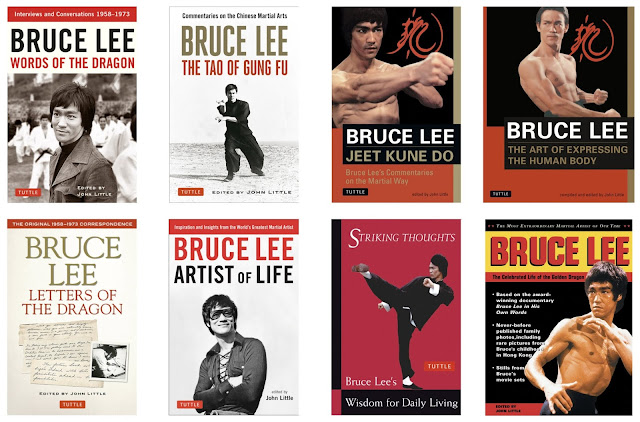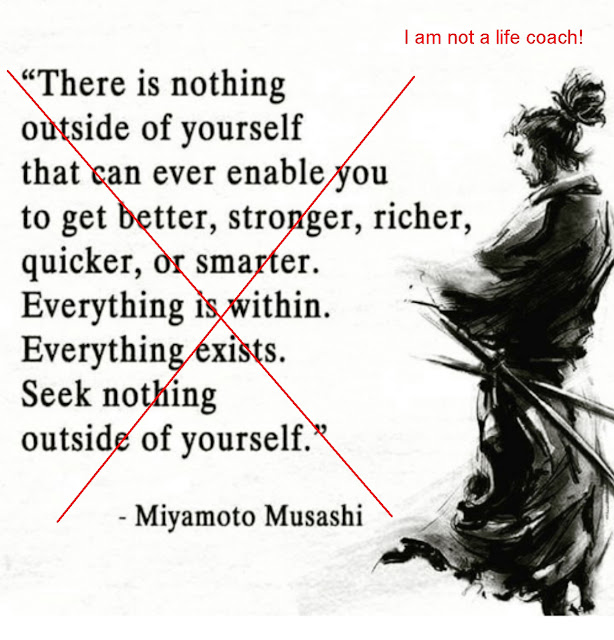May 2021 Book Survey: The Tuttle Bruce Lee Library
My reading theme for May 2021 was Tuttle's 8 volume Bruce Lee library. I (Richard) blogged about these titles in October 2020 in the post The Bruce Lee Library and More, but I did not offer any commentary on these 8 titles. This post will offer that commentary.
Introduction
- Bruce Lee: Words of the Dragon: Interviews, 1958-1973; 30 Nov 1997
- Bruce Lee: The Tao of Gung Fu: A Study in the Way of Chinese Martial Art; 15 Nov 1997
- Bruce Lee: Jeet Kune Do: Bruce Lee's Commentaries on the Martial Way; 15 Nov 1997
- Bruce Lee: The Art of Expressing the Human Body; 15 Nov 1998
- Bruce Lee: Letters of the Dragon: Correspondence, 1958-73; 15 Nov 1998
- Bruce Lee: Artist of Life; 15 Sep 1999
- Striking Thoughts: Bruce Lee's Wisdom for Daily Living; 1 Apr 2000
- Bruce Lee: The Celebrated Life of the Golden Dragon; 27 Nov 2000
These 8 books are the primary and most reliable sources for Bruce Lee's words. As literary executor for the Bruce Lee estate, Mr. Little had access to Mr. Lee's library and the Lee family.
Bruce Lee: Words of the Dragon: Interviews, 1958-1973; 30 Nov 1997
The first title, Bruce Lee: Words of the Dragon: Interviews, 1958-1973, might be more appropriately called "words about the dragon" rather than "words of the dragon." The book consists mainly of stories by reporters about Bruce Lee. The text does include a story written by Bruce Lee, published in a Taiwan newspaper, however.
This is one of the easier titles in the library to read cover-to-cover. As it is organized by date of publication, it follows Lee's life chronologically. It can be somewhat jarring to encounter the stereotypical and racists attitudes adopted by some of the reporters. This is a good book to read if one wants to get a sense of what the outside world thought of Bruce Lee during his lifetime.
Bruce Lee: The Tao of Gung Fu: A Study in the Way of Chinese Martial Art; 15 Nov 1997
Bruce Lee published a book called Chinese Gung Fu: The Philosophical Art of Self Defense in late 1963. This was the only title he wrote and published during his lifetime (despite what you may have seen in the fantastical 1993 movie "Dragon: The Bruce Lee Story.") He had planned to write a longer book about Gung Fu, but stopped working on it in 1965.
This title, Bruce Lee: The Tao of Gung Fu: A Study in the Way of Chinese Martial Art, is John Tuttle's reconstruction of this scrapped book. Mr Little did the best he could with what he had to work with, but I am not a big fan of this book. It's more useful as a snapshot of where Bruce Lee's mind was with respect to his personal view of Chinese martial arts.
For example, the book says "The art of straight hitting (punching in a straight and direct line) is the foundation of scientific skill. It is the end result of thousands of years of careful analysis and thought. The straight punch requires tremendous speed and intelligence to use... The straight punch, when thrown in alternating fashion for several series, is called the straight blast. I consider this form of multiple straight punching the heart of successful close-range attack." This was the same Wing Chun chain punch that could not finish Wong Jack Man, if you accept the story as being accurate. These are the thoughts of a person who believed that kung fu was "4,000 years old" and was the parent of all other martial arts.
Bruce Lee: Jeet Kune Do: Bruce Lee's Commentaries on the Martial Way; 15 Nov 1997
The third title in the library is Bruce Lee: Jeet Kune Do: Bruce Lee's Commentaries on the Martial Way. It's essentially material Lee wrote in 1970 after injuring his back doing a weightlifting exercise. Lee's friend Ted Wong says of the book "while some of the combative beliefs, philosophy, and illustrations that Bruce committed to paper during this period of his convalescence became The Tao of Jeet Kune Do, (Ohara Publications, 1975), many of them did not. And it is these other writings that have filled this book."
Mr Little notes "Lee wrote and self-published one book, prepared manuscripts for two additional books (that he later decided not to have published), authored several articles that were published on the theory and nature of unarmed combat, scripted no less than three screenplays, and penned seven volumes of writings containing his thoughts, ideas, opinions, and research into the science and art of unarmed combat... It has taken this author over three years to research all of the existing materials of Bruce Lee (although in truth, I’ve been studying Lee and his writings for well over two decades), and another year to edit them into the manuscript that became this book."
Unfortunately, I am not a fan of this volume. It seemed like a rambling aggregation of disjointed material. Although this is only the third title in the series, I already noticed repeated content from the first two volumes. I believe the original The Tao of Jeet Kune Do, published after Lee's death in 1973, is a more coherent work.
Bruce Lee: The Art of Expressing the Human Body; 15 Nov 1998
Volume 4 is Bruce Lee: The Art of Expressing the Human Body. At the beginning, I was not that interested in this book. Although I am impressed by Mr Lee's physique, I was not especially concerned with his training methods. However, this book won me over. This title is a coherent presentation of Lee's training routines over time. Mr Little presents sample routines from different stages of Lee's life and his rationale for each. This was probably the most practical and actionable book in the library thus far.
Bruce Lee: Letters of the Dragon: Correspondence, 1958-73; 15 Nov 1998
Volume 5 is Bruce Lee: Letters of the Dragon: Correspondence, 1958-73, and I had high hopes for this book. Mr Little did not disappoint. This title presents reproductions of letters written by Bruce Lee over a 15 year period. They appear chronologically, as best understood by the editor. This organizational choice was a good one, and it reminded me that Bruce Lee would have been a prolific blogger had he lived in the 21st century. This is one of my favorite titles in the library.
Bruce Lee: Artist of Life; 15 Sep 1999
Volume 6, Bruce Lee: Artist of Life, is a comprehensive collection of writing by Mr Lee. Unfortunately, it contains a lot of material from previous library titles -- and explicitly says so. Furthermore, the book includes Lee's notes and reproductions from other works. Mr Little says: "Many of his entries (the excerpts from Eric Hoffer’s The Passionate State of Mind and Frederick S. Perls’ books on Gestalt therapy, for example) have been included, to share some of Lee’s influences and the attitudes and worldviews he found congenial." This can be a source of confusion for many Lee fans, as they believe Lee is the source of material that properly belongs to thinkers like Jiddu Krishnamurti or Alan Watts.
Striking Thoughts: Bruce Lee's Wisdom for Daily Living; 1 Apr 2000
The 7th title, Striking Thoughts: Bruce Lee's Wisdom for Daily Living, departs from the appearance and organization of the previous 6 titles. However, it is one of my favorites in the series. Mr Little notes "The title Striking Thoughts is taken from a heading that Bruce Lee created for a series of maxims he wrote down after reading the philosopher Jiddu Krishnamurti's book First and Last Freedom." Striking Thoughts is a collection of pithy sayings organized by topic, perfect for anyone looking for inspiration from Mr Lee.
Bruce Lee: The Celebrated Life of the Golden Dragon; 27 Nov 2000
The last title in Tuttle's Bruce Lee Library is Bruce Lee: The Celebrated Life of the Golden Dragon. Similar to the previous volume, this title takes a different look and feel compared to the first 6 books. This book is based on Mr Little's 1998 documentary short (<20 minutes) titled Bruce Lee: In His Own Words. It's available online if you look for it. This is a short book, but the photography is excellent and I think it's a valuable companion to the documentary.
Conclusion
Before finishing, I'd like to thank Tuttle for contributing three electronic volumes to my library, helping make it possible to complete this project.
Overall, I enjoyed these books. They are mainly Bruce Lee's own words, which helps them remain faithful to his views. I did find a few points annoying, such as Mr Little's repetition of the myth that Bruce Lee invented the Kung Fu TV series. Thankfully the fact that Ed Spielman invented the Kung Fu TV series is finally gaining ground, nearly 30 years after the mainly fictional 1993 Dragon "biopic" inserted that and other fantasies into the Bruce Lee mythology.
I'll offer a couple suggestions regarding this series.
If you are any sort of Bruce Lee researcher, as I am with respect to the Sourcing Bruce Lee project, you need all 8 books. You'll need other books too -- see The Bruce Lee Library and More for details.
If you're a casual fan, I suggest Striking Thoughts: Bruce Lee's Wisdom for Daily Living. It's the best thematic collection of Mr Lee's inspirational material.
Finally, if you have a specific interest -- like Bruce Lee's training methods, or additional details on his views of kung fu or jeet kune do -- then read the corresponding specific book.
For next month's reading, I'm probably returning to Japan to look at books on the development of budo.
If you like this article, check out our Facebook page, Instagram account, Twitter feed, and Amazon Wish List. Be devoted!













Comments
Post a Comment